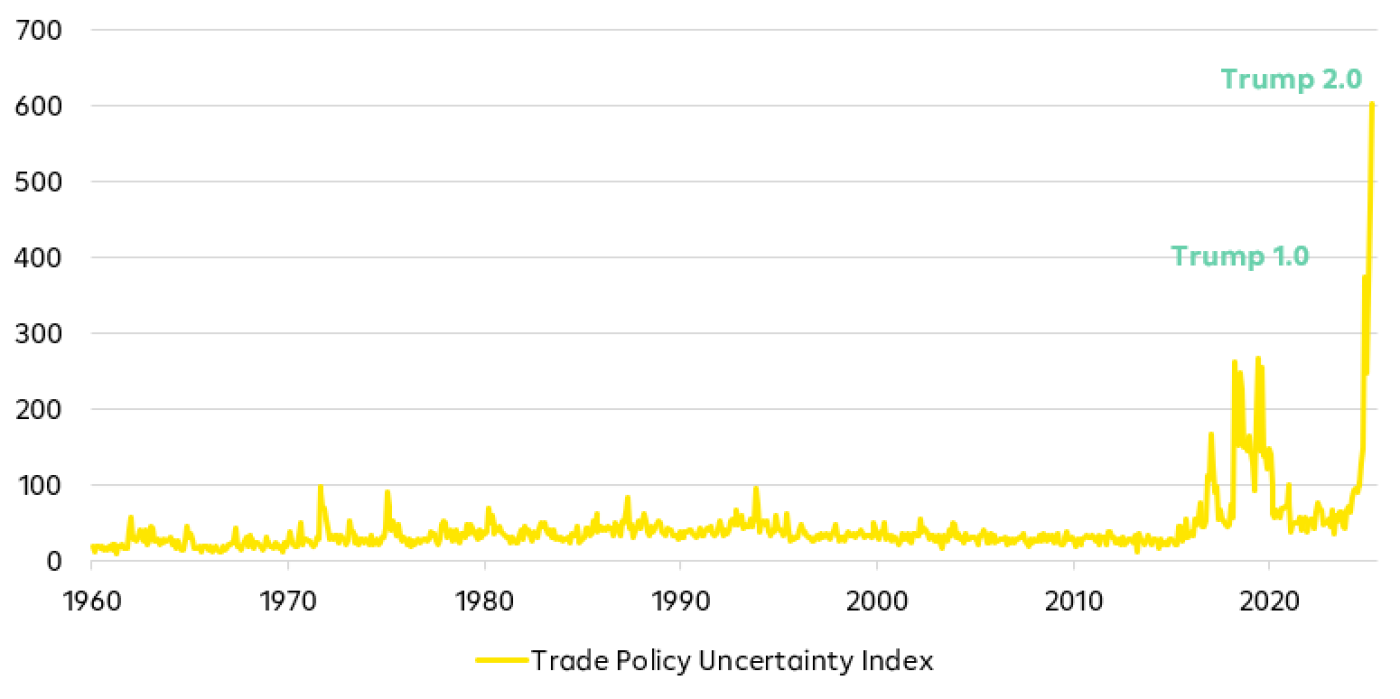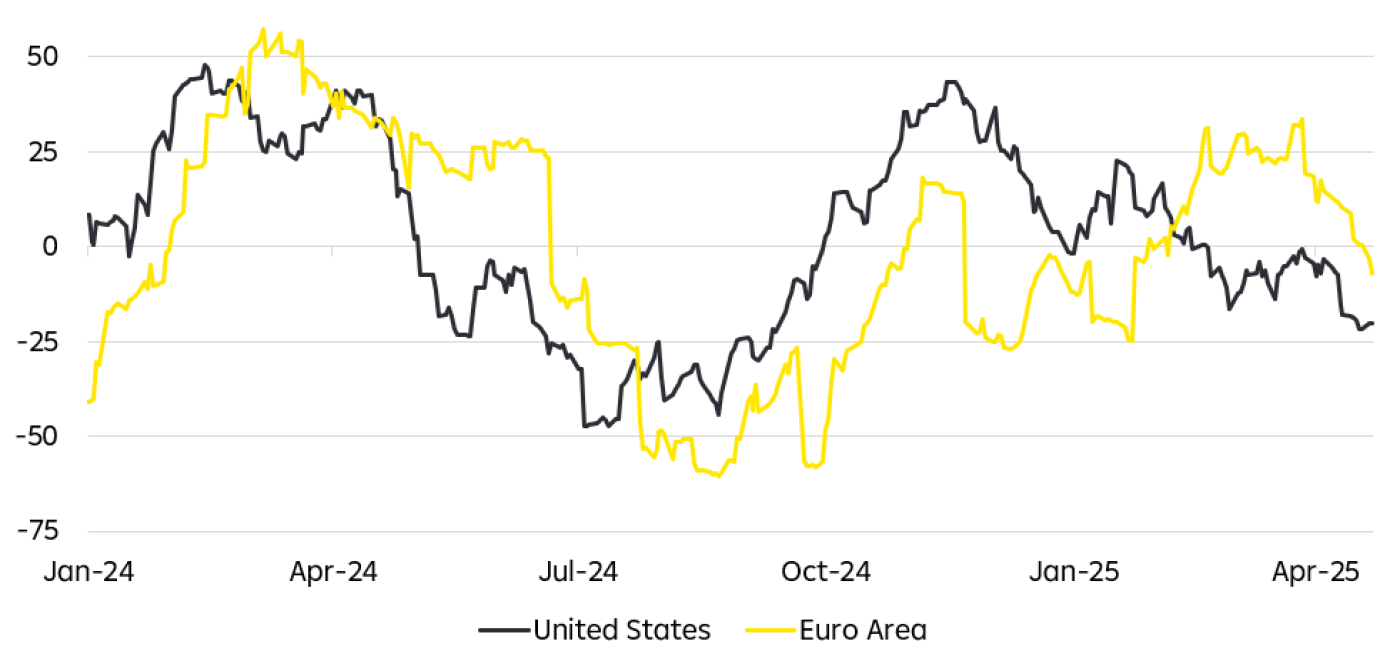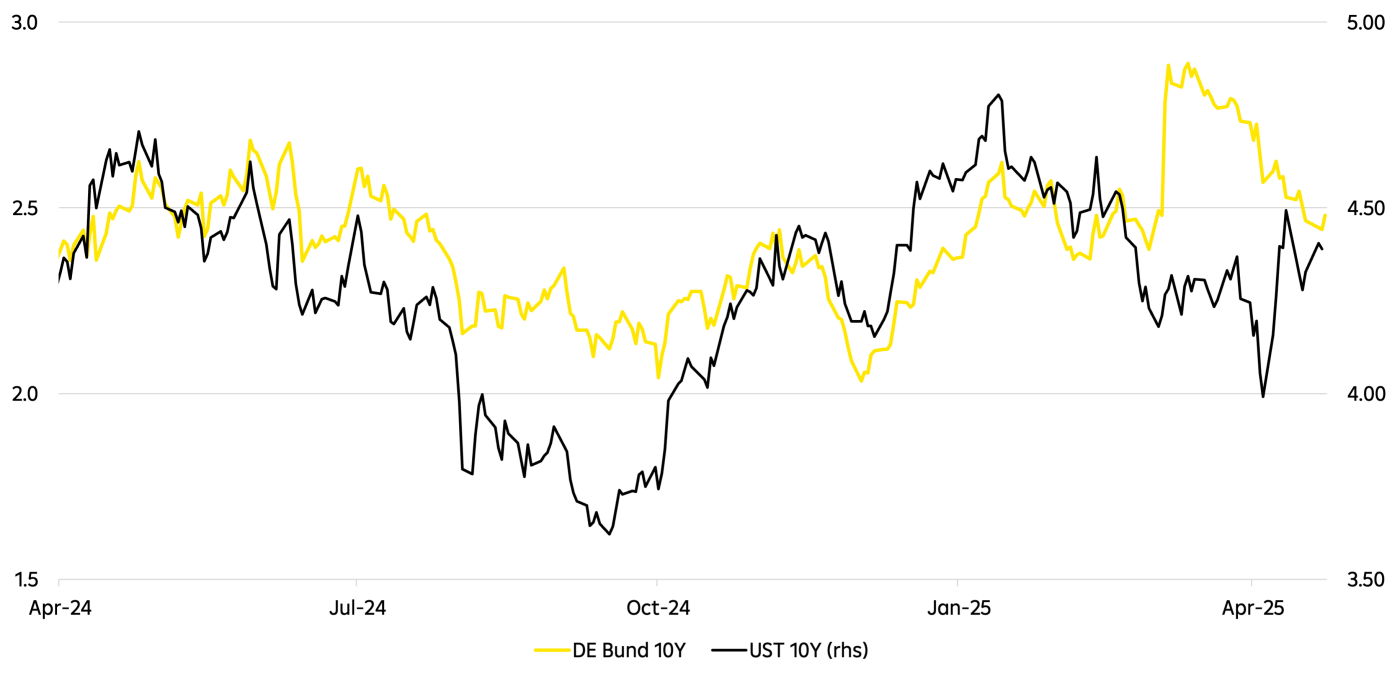
Franz Zobl
Senior Economist

When Trump took office on January 20, 2025 financial markets had a clear view on the new president’s impact. The so-called Trump Trade, which started to unfold in early November 2024 implied rising prices on equity markets, higher bond yields and an appreciation of the US dollar. This describes the expectations towards US markets, in particular. For Europe, the picture was seen more ambiguous. Downside risks to Europe’s economic outlook dominated the debate causing expectations to be built towards a relative underperformance of European equity markets, an outperformance of German government debt as the currency area’s safe haven and a depreciation of the euro. Looking back at the first months of Trump’s term in office things couldn’t be more different. US equity market corrected to the downside, the European equity market first outperformed and then followed the global trend, US Treasury and German Bund yields are both down but yield curves steepened significantly and the EUR/USD exchange rate increased markedly.
The experience of the past few months clearly highlights that managing risk is essential for being successful in the long-term. Even well-informed agents can be caught off guard by economic or political shocks. And it is to be expected that not only the past few years but also the years ahead will be characterized by unforeseen events. The reason is that political uncertainty is at an all-time high. Trump has a big share in this. His exceptionally erratic approach to diplomacy has clearly intensified compared to his first term in office. Trade policy is the obvious example. Trade policy uncertainty rose to unprecedented levels in post-WWII history.

Looking at trade policy it is astonishing to see how Trump is rewriting the global order. The debate on negative economic repercussions from the trade war has quite rapidly focused on the US, rather than its trading partners. Fears of the US economy being pushed into a recession started to become a dominant market topic, much more so than in Europe. It is, however, important to keep the starting position in mind. On financial markets price changes need to be viewed relative to previously held expectations. And here the US economy is looking back at a very successful year 2024. The US economy was performing solidly. In Europe, however, economic growth underperformed as the hoped for economic recovery failed to materialize. Looking ahead, the negative growth effects from the tariff shock, thus, have a larger potential to rewrite the economic outlook for the US rather than for Europe. Simply due to the fact that expectations towards the US economy were much more favourable to start with.

While a shift towards US-protectionism has always been seen as negative for Europe’s economic outlook and as ambiguous for Europe’s inflation outlook, it is seen as pro-inflationary for US consumers. For US monetary policy this implies that the Fed has to balance upside risks to its inflation mandate with downside risks to its labour market mandate. Not an easy task, particularly when considering that the last inflation shock is not long ago. The Fed might thus be more cautious with ‘looking through’ rising inflation. This does not necessarily mean rate hikes are imminent but rather a more cautious approach towards rate cuts. In anticipation of a challenging inflation environment the Fed has not decreased key interest rates so far in 2025 and we expect this to remain the case for most of the year. On financial markets rate cuts started to be priced for the second half of the year as the focus shifted towards discussing a US recession. For the Fed, 2025 will be a balancing act. If the economy only slows but does not fall into recession and inflationary pressures at the same time re-appear, the rates market might currently be positioned too optimistically on rate cuts. For equity markets, which have corrected on the back of tariff induced recession talks, this implies that the Fed put might this time not be pulled. On the one hand, the long-term outlook on US equities remains constructive as long as the US economy avoids recession. But, on the other hand, interest rates might be a head- not a tailwind for equity markets over the coming months.
In Europe, Trump is not only about tariffs. Particularly in the first weeks of Trump’s second term, Europe has been fully occupied by Trump’s push for a peace deal between Ukraine and Russia. The US’s approach towards Ukraine under Trump can be described as a U-turn compared to Biden’s approach. European leaders were shocked and started to question the US’s security guarantees within NATO. On financial markets prospects of a peace deal, and the at least partial suspension of sanctions, lifted sentiment in European markets. European equity markets rallied, energy prices embarked on a downward trend and the euro appreciated. Given the current positioning on markets, the question arises whether a quick, yet long-lasting solution, is possible. US pressure alone won’t do the trick and so there is a risk that markets will be disappointed on the geopolitical front.
What US pressure, however, achieved is a change of thinking about European security policy and military spending. Germany is the prime example. Under chancellor Merz, Germany has softened the debt brake by basically allowing unlimited spending on military plus a sizeable budget allowance on infrastructure. It’s Germany’s ‘whatever it takes’ moment, so Merz. Combined with Brussel’s flexibility on deficit / public debt rules for the EU as a whole, Europe’s push to take security seriously triggered a repricing on sovereign bond markets and an appreciation of the euro. On the one hand, debt financed government expenditures increases the expected supply of bonds on the market. On the other hand, it is also a fiscal stimulus for economic growth and with that for inflation. The repricing on bond markets came with higher sovereign yields, particularly for longer maturity bonds. The yield curve steepened markedly.

While fiscal policy and a wall of public debt issuances has been a crucial topic on European bond markets, it is interesting to see that this is not a key market topic in the US. The US has been on an unsustainable public debt trajectory for years and neither Democrats nor Republicans seem to worry about it. Yet, even for Trump the actual fiscal space is small, and key initiatives might at first be limited to prolonging tax cuts from his first term. Whether tariff policy will provide him the revenues he wishes for remains to be seen. Unsound public finances speak for short-term volatility with yields spiking on the Treasury market, particular in times when the global reserve currency status of the US dollar is questioned. In an adverse scenario the trust in the US financial system could be undermined and weaken the US dollar even further.
Summing up, the first three months of Trump in office show that things turned out quite different than commonly expected. In times of elevated political uncertainty and more frequent shocks even to advanced economies, an open approach towards risk scenarios is incremental. So far, financial markets are struggling with ‘known unknowns’. Managing those well will be important to obtain the flexibility in dealing with ‘unknown unknowns’.

Senior Economist
IMPORTANT NOTICES
This document is a marketing communication.
The country specific amendments at the end of these notices are explicitly drawn to the attention of the recipient of this document. To the extent the country specific amendments contradict the other content of these notices, the country specific amendments will prevail with respect to the jurisdiction to which the respective country specific amendments relate.
This document has been prepared by the following staff employed at Group Capital Markets, a division of Raiffeisen Bank International AG:
Name, position:
__________________________
Name, position:
__________________________
Raiffeisen Bank International AG ("RBI"), an Austrian credit institution supervised by the Austrian Financial Markets Authority (Finanzmarktaufsicht – FMA) and the Austrian Central Bank (Oesterreichischen Nationalbank – OeNB), is responsible for this document. RBI is also supervised by the European Central Bank ("ECB") within the framework of the Single Supervisory Mechanism ("SSM"), comprising ECB and the competent national authorities as per Council Regulation (EU) No 1024/2013 of 15 October 2013 ("SSM Regulation").
This document does not constitute a financial analysis and has not been prepared by financial analysts in observance of the legal rules on the enhancement of the independence of financial analyses and is not subject to any prohibition on dealing ahead of the dissemination of investment research.
This document may include references to financial instruments in relation to which RBI may act as market maker, and in which it is likely as principal to have a long or short position at any time, including possibly a position that was accumulated on the basis of the information contained herein prior to its dissemination. RBI may engage in transactions, for its own account or with customers, in a manner inconsistent with the views taken in this document. Others within RBI, including strategists, sales staff and other analysts, may take views that are inconsistent with those taken in this document.
Any figures on performance indicators relate to the past only. Past performance is not necessarily a reliable indication of future results or, in particular, the future performance of financial instruments. This is particularly true for financial instruments that have been offered for trade for of period of less than 12 months in view of such specifically short reference period.
The performance of financial instruments can be impaired by commissions, fees, taxes and other expenses that may be charged depending on circumstances relative to a given investment or investor.
Forecasts are based merely on estimates and assumptions. Actual future performance may deviate from such forecasts. Forecasts are not a reliable source of predicting future results or the future performance of financial instruments.
This document has been prepared for information purposes and exclusively for the purposes of distribution to professional clients as defined in Article 4(1)(10) of Directive 2014/65/EU (including, for the avoidance of doubt, eligible counterparties as defined in Article 30(2) of Directive 2014/65/EU and transposing national legislations) of RBI. THIS DOCUMENT IS NOT INTENDED TO BE PROVIDED TO RETAIL CLIENTS AS DEFINED IN ARTICLE 4(1)(11) OF DIRECTIVE 2014/65/EU (I.E. ALL CLIENTS OTHER THAN PROFESSIONAL CLIENTS, AS DEFINED ABOVE) OR, IF DIFFERENT, CONSUMERS AS DEFINED BY THE RELEVANT APPLICABLE DOMESTIC STATUTORY PROVISIONS OR, IF DIFFERENT, ANY OTHER PERSON NOT ELIGIBLE FOR RECEIPT AS STATED ABOVE AND MUST IN CONSEQUENCE NOT BE FORWARDED TO RETAIL CLIENTS OR, IF DIFFERENT, CONSUMERS OR, IF DIFFERENT, ANY OTHER PERSON NOT ELIGIBLE FOR RECEIPT AS STATED ABOVE WHETHER IN WHOLE OR IN PART. The recipient hereof shall treat this document and the information contained herein as confidential and may not, whether in whole or in part, disclose, distribute or reproduce this document or make use of it for any other purposes.
Additional detailed legal and risk information can be accessed here: https://www.rbinternational.com/en/home/legal/important-notices.html